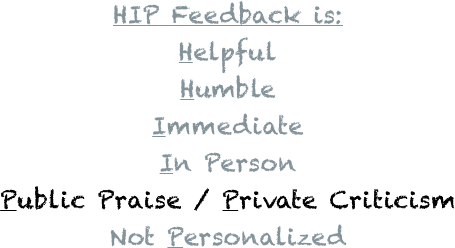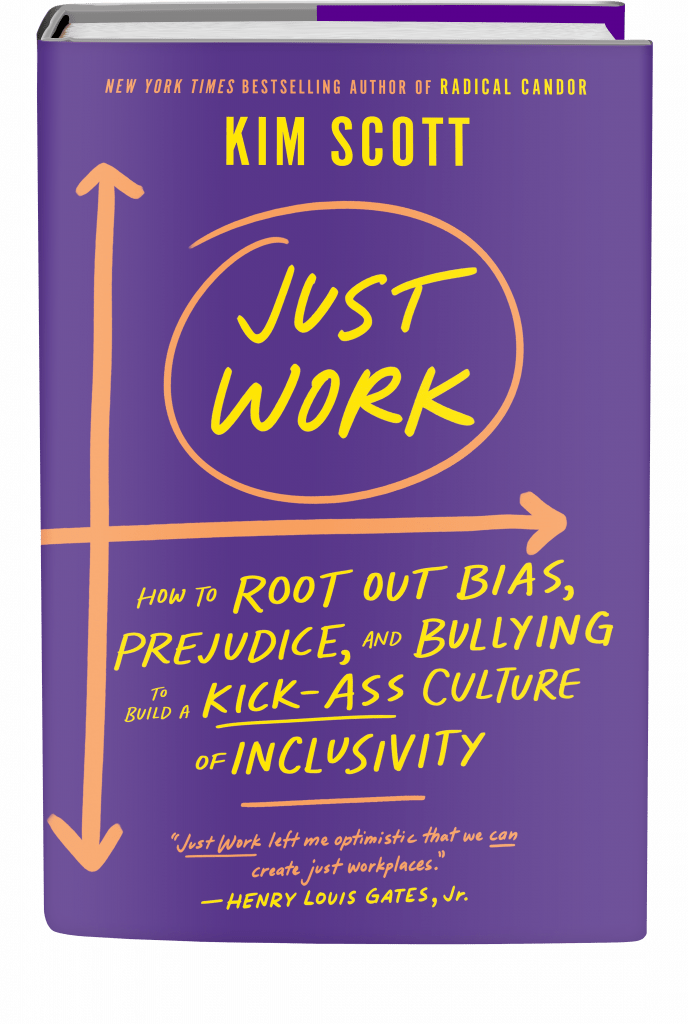Kim Scott is the author of Radical Candor: Be a Kick-Ass Boss Without Losing Your Humanity and Radical…
Why Praising in Public and Criticizing in Private is Key to Giving Feedback Others Will Act On
A good rule of thumb for guidance is praise in public, criticize in private.
Public criticism tends to trigger a defensive reaction and make it much harder for a person to accept they’ve made a mistake and to learn from it.
Public praise tends to lend more weight to the praise, and it encourages others to emulate whatever was great. However, this is a rule of thumb, not a hard and fast rule.
For those of you who find mnemonics helpful, these are the fifth of our six tips for giving Radically Candid feedback. Be HIP, or HHIIPP.
Public praise is great for both recognition and learning. When you share specifically what was great and why it was great publicly, not only does it have more meaning for the person being praised, it helps the whole team learn something new.
Make sure to provide details about what the person did, the impact, and the context so that the whole team learns.
For example, don’t say, “Alex did a great job.” Instead say, “Alex came up with the idea for X and then got budget for it. As a result, you are all 85% more efficient. That means less grunt work and more time for cool projects for everyone. Thank you Alex!”
Private criticism is important in order to be kind and clear. Radical Candor is not the same thing as “front-stabbing”, and it’s much kinder to criticize someone in private.
Public criticism can feel unnecessarily harsh. Private criticism will also be more clear because it’s much less likely to trigger a person’s defense mechanisms.
Defensive reactions make it much harder for a person to accept they’ve made a mistake and to learn from it.
However, “Public Praise / Private Criticism” is a rule of thumb, not a hard and fast rule. The key things to keep top of mind are these basic questions:
Are you showing that you Care Personally?
Are you Challenging Directly?
If the answer to those questions is yes, you’re in good shape, even if you’re violating the rule of thumb. Consider these possible exceptions:
Individual preferences
While the majority of people do like to be praised in public, for a few any kind of public mention is cruel and unusual punishment. When praising people your goal is to let them know what they did well as clearly as possible and in the way that will be best for them — not the way you’d like to hear it.
Remember, Radical Candor is measured at the listener’s ear, not the speaker’s mouth.”
That’s why we recommend a variation on the Golden Rule for feedback. If the Golden Rule is “Do unto others as you would have them do unto you,” it’s better to “Do unto others as they would have you do unto them” when giving feedback.
When you are focused on caring personally, you will naturally be more aware of the other person’s preferences and adjusting for these preferences is easy.
Group learning
You may want to consider the opportunity for group learning for both praise and criticism. Praising in public has the great effect of showing everyone what success looks like so that they can learn from the accomplishments of others.
Whenever I praise in public, I like to be explicit about this public learning, saying something like, “Because I want to make sure all of you learn from what Jane did, I’m going to reiterate what I said in All-Hands today.”
When I want to encourage public criticism so that everyone learns from each other’s mistakes, I let it be self-reported. I try to make people feel comfortable admitting mistakes by building a culture of self-criticism.
You are the exception to the rule
Great bosses don’t criticize in public, and they discourage employees from criticizing each other in public. However, they encourage employees to criticize them in public. Getting criticized in public gives the boss an opportunity to model appreciation for the criticism, to accept it as a gift.
Great bosses encourage employees to criticize them in public.”
It also saves time — if one person has a criticism of you, it’s likely others do as well. You can address that issue for everyone all at once if you do it in public.
Finally, there’s one boss and a lot of employees so it’s harder to get on the boss’s calendar — employees have got to catch as catch can, and sometimes that means in public.
Multiple modes
Praising people at a public all-hands meeting is a great way to share significant accomplishments. Following this up with a public email to the whole team solidifies the praise even more.
But that doesn’t mean you only have to praise publicly. Following up your public praise with another mention of the accomplishment one on one carries a lot of emotional weight and shows that you Care Personally.
What do you think of these exceptions? What are your tips and reminders for praising publicly and criticizing privately?
*This post was updated April 5, 2022
————————————————————————————————————————————————————————————–
Sign up for our Radical Candor email newsletter >>
Shop the Radial Candor store >>
Book a keynote or workshop >>
Need help practicing Radical Candor? Then you need The Feedback Loop (think Groundhog Day meets The Office), a 5-episode workplace comedy series starring David Alan Grier that brings to life Radical Candor’s simple framework for navigating candid conversations.
You’ll get an hour of hilarious content about a team whose feedback fails are costing them business; improv-inspired exercises to teach everyone the skills they need to work better together, and after-episode action plans you can put into practice immediately to up your helpful feedback EQ.
We’re offering Radical Candor readers 10% off the self-paced e-course. Follow this link and enter the promo code FEEDBACK at checkout.







